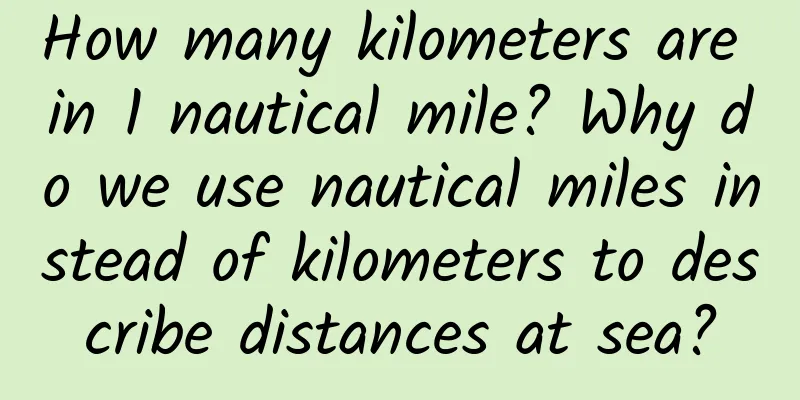How many kilometers are in 1 nautical mile? Why do we use nautical miles instead of kilometers to describe distances at sea?

|
It is common knowledge that one kilometer is equal to 1000 meters. Both kilometers and meters are units of measurement for length on land. The one-kilometer physical test during my student days was painful When at sea, people do not use kilometers but nautical miles to describe distance. Why do we use nautical miles instead of kilometers at sea? The origin of the sea In people's earliest sea voyages, due to the lack of reference points, people could not accurately calculate the speed of the ship or the distance they had sailed. This problem continued until someone proposed that the earth is a sphere, and then smart people began to plan the longitude and latitude lines on the earth. The emergence of longitude made it possible for people to measure distances at sea. warp In fact, as early as BC, people speculated that the earth was a round sphere and planned a preliminary meridian map for the sphere. In the planning of longitude, later generations divided the circumference of the earth into 360 degrees based on the meridian maps left by the ancients. Each degree was further divided into 60 minutes, and the length of each minute corresponded to a distance of one nautical mile. Since the earth is an irregular sphere, it is wider in the middle and slightly smaller on both sides. When calculating nautical miles, the standards for calculating nautical miles at different locations are also different. The Earth looks like a standard sphere Generally, the length of a nautical mile is shortest at the equator and longest at the poles, with a difference of about 20 meters. The specific calculation formula is "2 times the length of the meridian ÷ 360 ÷ 60 = 1 nautical mile". According to the Chinese standard nautical mile distance, one nautical mile is equal to 1.852 kilometers, which is equal to 1852 meters. Due to differences in longitude and latitude, countries have different definitions of standard nautical miles. One U.S. nautical mile is equal to 1.85101 kilometers. The shortest standard distance of a nautical mile is 1,843 meters and the longest is 1,862 meters. The vast ocean According to this calculation method, people can also deduce that the average radius of the earth is 6371300m. This is a very convenient and universal calculation method that can infer many distance units on the earth. Friends in the Sea: Festival Having nautical miles alone is not enough. When sailing on a ship, people still cannot tell how many nautical miles they have sailed, especially at night when everyone is asleep and no one can remember how far they have sailed the next day. In the beginning, in order to solve this problem, sailors usually tied a knot on the rope, and one knot represented a distance of one nautical mile. When the voyage was over, the sailors counted the knots on the rope to determine the nautical miles they had traveled, and this ancient way of recording was preserved. With the advancement of human technology, the invention of ship recorders and clocks has made the status of knot counting precarious. Although people no longer use the festival to count, as a symbol of human wisdom and with a profound historical and cultural heritage, the festival is still used as a unit of measurement today and is also recognized by the international community. kilometer Kilometer, also known as kilometre, comes from the British word kilometre. In later units, people directly used km as the suffix to represent kilometers. In 1790, a committee of scientists formed in France formally decided to propose the kilometer as the national unit of measurement, which was defined as "one three hundred thousandth of the distance traveled by light in a vacuum in one second." Later, as people's means of transportation improved, the speeds they could achieve became faster and faster, and people discovered that kilometers were a good unit of measurement for modern society. Compared with other units of measurement, if you want to calculate the speed of an airplane, the number in meters seems too large, but it does not reach the length of a light year. The kilometer unit is just right, and it has become popular around the world. Before the world unified its standards, different countries had different units of measurement for distance, and different units of measurement hindered the development of other industries such as navigation. The development of maritime industry promotes social progress So when ships in medieval Europe were sailing, there was an urgent need for a unified unit of measurement to measure the distance on the sea and the speed of the ship. The nautical mile came into being. It has its own unique calculation method. No matter where on the earth, the nautical mile unit is the same. Its wide applicability has allowed it to be passed down. Even after the world unified its unit of length, the nautical mile remained one of the important units of maritime distance due to historical and cultural factors. Of course, sometimes in order to facilitate public reading, nautical miles are converted into kilometers in many news reports. Long sea journey There is no clear dividing line between the two. As long as the concept of distance can be expressed, either term can be used. The new generation, who are used to counting kilometers, may discard it because they do not understand the nautical mile unit. This is indeed the case. In the new era, there are many tools to measure the width and distance of the ocean, such as acoustic wave detection, spacecraft detection, flight detection and other technologies are very mature. If you just want to know the distance and speed of a ship in the sea, a navigation recorder is enough. The method of calculating nautical miles seems to be outdated. Modern Ship Don't forget that the nautical mile represents human wisdom. Even if it becomes an unpopular unit of measurement one day, the historical and cultural heritage it contains will be immortal, and with the passage of time, the historical and cultural heritage will also gradually increase. Other units of measurement After understanding the emergence and concepts of nautical miles and kilometers, other units of measurement are also indispensable in people's lives. The unit that is closest to humans is meter. Meter is not only the best unit of measurement for humans themselves, but also the most applicable unit. The origin of the meter unit is defined as "one ten-millionth of the distance from the Earth's equator to the North Pole on the meridian through Paris" In 1688, a British philosopher proposed that human society needed a unified unit of length to measure the distance between all things in time, so that humans could have a better concept of distance. The definition of meter was first proposed after the French Revolution in 1789, and the concept of the word metro cattolico was adopted in a paper by an Italian scientist. This word is derived from ancient Greek and means "universal unit of measurement". As ancient Greece was the civilization with the most developed mathematics in ancient human history, its meaning is authoritative. Ancient Greece was not only a civilization with advanced mathematics, but also laid the most basic algorithms for the future mathematical world. Its more famous works include "The Complete Works of Archimedes", "Theory of Conic Sections" and "Elements of Geometry". The three works represent the highest achievements of ancient Greek mathematics. Before the advent of modern science, the position of the three works was difficult to shake. After France applied the concept of ancient Greek, it abbreviated the unit of meter into m. According to the decimal calculation at that time, one thousand meters was equal to one kilometer. Kilometers are defined based on light years, so what kind of magical existence is light years that can have such great power? Light year is rarely used in people's daily life, but it is a very common unit of measurement in astronomy. Simulating how light looks in the universe Although light-year contains the word "year", it is a unit of measurement of distance. As the name suggests, light-year is the distance that light travels in one year. Previously, people always believed that the propagation of light does not require time. It was not until 1676 that Danish scientists proposed the hypothesis that the propagation of light requires time. Only then did people begin to gradually shift their focus to the propagation of light. Due to limited technological capabilities, it was not until the 18th century that a large number of scientific experiments proved that the propagation of light does take time. In 1728, British astronomers measured the speed of light for the first time at 300,000 kilometers per second. Later, after repeated measurements, people concluded that the speed of light in a vacuum is 299,792.458 kilometers per second, which is the fastest speed discovered by mankind so far. Propagation of light Einstein's theory of relativity believes that matter cannot exceed the speed of light. The closer an object's speed is to the speed of light, the slower the time passes for this object. The light-year unit seems to be magical in astronomy, and the distance measured by this unit is also astonishingly large, but for the universe, the light-year unit seems to be insufficient. The radius of the current observable universe is 45.6 billion light-years, and the boundary of the universe is expanding at superluminal speed. That is to say, when human technology is able to explore the deeper universe, the distance measurement of light years will seem small enough. By then, humans may find something that can move faster than light. (Statement: This article is from Cosmic Decoding. It is reproduced for learning and communication only, not for commercial purposes. All reproduced articles will indicate the source. If the original author of the article or photo has any objection, please contact us in the background and we will quickly process or delete it. Thank you for your support.) |
<<: Qingbaijiang, another code of Chengdu to the world
Recommend
When exploring an extraterrestrial planet, does the probe fly in a straight line? Learn more about the Hohmann transfer orbit
In "Elements" written by the ancient Gr...
Those who are supposed to leave will eventually be gone. Party media says Tesla production and sales should be completely stopped
Recently, Driving Vision learned from the party m...
Strategies to improve user retention
I have written an article in my previous diary ca...
"Douyin Commercial IP Core Practice Course" takes you to play with algorithms, traffic, content, architecture, and monetization
"Douyin Commercial IP Core Practice Course&q...
Lumia1020 try to play the voice of the girl
Microsoft released the new Windows Phone 8.1 opera...
How to turn on activity conversion? Share 3 types of gameplay with built-in traffic!
Regardless of the type of activity, the ultimate ...
June stargazing guide: Supermoon and meteor showers add color to the most beautiful Milky Way
Original title: June stargazing guide: "Supe...
"Metaverse", "Break the Defense", "Booster Shot"... Which one is your buzzword of the year?
Loading long image... Source: Xinhua News Agency...
JD.com traffic has reached a bottleneck? 3 indicators and 5 factors to help you improve conversion
People often ask, which category is easy to do on...
Offline Activities Execution Table (SOP)
The organization of an offline event is much more...
Brand marketing promotion: Why does Haidilao never advertise?
As a leader in the catering industry, Haidilao is...
Why are giant salamanders becoming extinct in the wild?
The giant salamander is a commodity, and is farme...
Lack of this vitamin may lead to Alzheimer's disease...
Reviewer of this article: Chen Haixu, Deputy Dire...
WeChat 7.0.9 beta update: Public account name is displayed when forwarding text and picture messages
On November 22, WeChat 7.0.9 beta version was upd...
How are cat poop coffee and decaffeinated coffee made? Four reasons for coffee
What are the basic categories of coffee? Big-frui...









